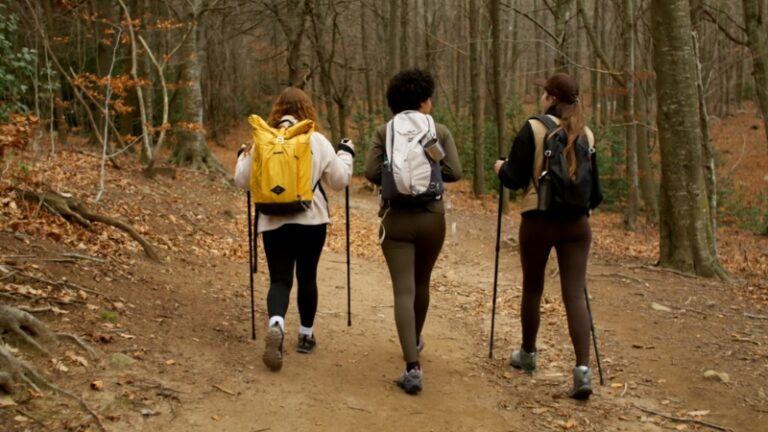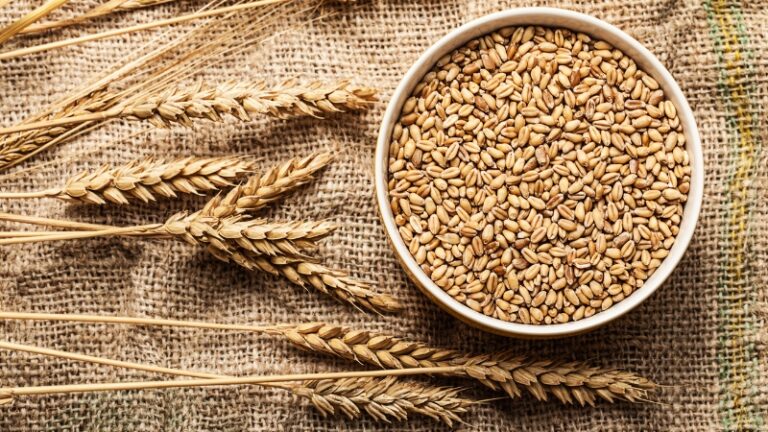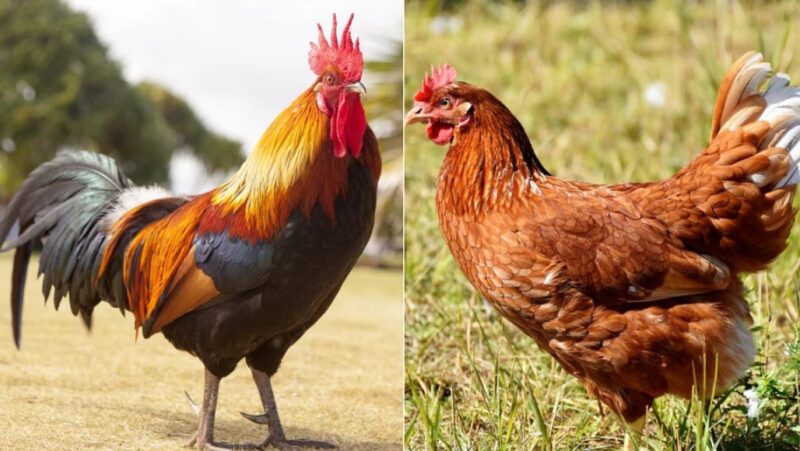Raising chickens brings an incredible opportunity to witness the unique behaviors and roles that roosters and hens play in a flock.
You might assume they’re all the same, but roosters and hens—though both part of the same species, Gallus gallus domesticus—have some fascinating differences that make each one special.
Let’s talk about their contrasting behaviors, physical traits, and their roles within a flock.
Key Differences
- Roosters are leaders and protectors: Roosters take charge of the flock by defending against predators, maintaining order, and leading the hens during foraging.
- Hens focus on reproduction and nurturing: Hens lay eggs regularly and show brooding behaviors, playing a crucial role in caring for their offspring, while being less assertive than roosters.
- Physical differences reflect roles: Roosters are larger with showy feathers, spurs, and louder crowing, while hens are smaller, quieter, and more focused on warmth and camouflage.
1. Behavioral Differences
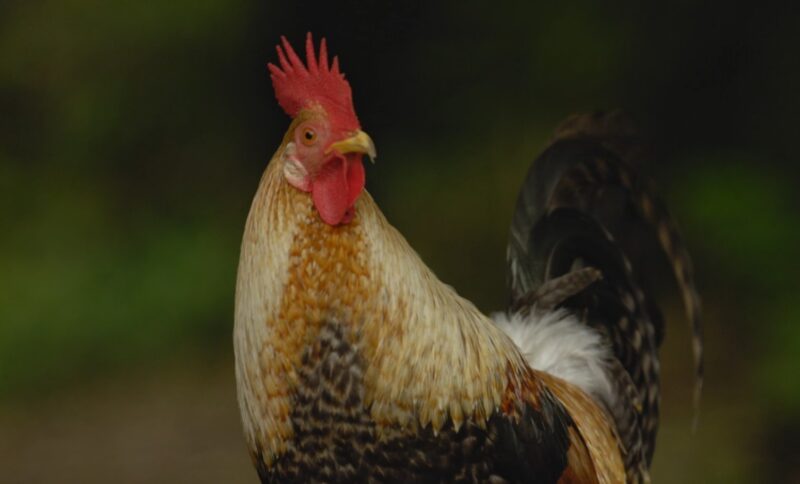
Social Hierarchy and Dominance
Roosters take the role of the boss in the chicken world. They’re assertive and watch over their flock like a dedicated leader. It doesn’t matter if it’s calling out danger or keeping the hens together, the rooster’s main task is protection.
You’ll often notice them engaging in territorial behaviors, especially around other roosters. They’ll stand tall, puff out their chests, and won’t hesitate to defend their domain. Hens, on the other hand, are typically more laid-back.
They rely on the rooster for guidance and safety. However, if no rooster is present, it’s not uncommon for one hen to take charge. Even in that scenario, a dominant hen won’t display the same level of aggression or territoriality that’s so common in roosters.
Crowing vs. Clucking
One of the most obvious behavioral differences between a rooster and a hen is their sounds. Roosters are infamous for their crowing, and despite what people think, it’s not just a morning routine.
Roosters crow at all times of the day, announcing their presence to other roosters, attracting hens, or signaling danger. Hens, on the other hand, are generally quieter. Their soft clucking is more communicative and nurturing, especially when they lay eggs or call to their chicks.
Hens can make louder sounds to alert the flock of a predator, but they don’t crow like their male counterparts.
Mating Rituals
Rooster mating behavior is fascinating to watch. They put on a show—literally! Roosters court hens by dropping one wing and circling the hen, performing what’s often referred to as a dance.
Once a hen is receptive, mating follows. Roosters aren’t picky about their mates, often courting multiple hens in the flock. Hens don’t have elaborate mating behaviors. If she’s receptive, she’ll allow the rooster to approach.
However, if a hen isn’t interested, she’ll let him know by making noise, running away, or simply ignoring him. It’s a funny yet practical dynamic.
Brooding Instincts
Here’s a big one: only hens go broody. When a hen becomes broody, she’s in full mom-mode, sitting on her eggs to incubate them. She might even become more defensive of her space during this time.
Roosters have no role in this process—they’re busy continuing their protective duties. A broody hen’s nurturing side is a powerful contrast to the rooster’s vigilant one.
2. Physical Differences
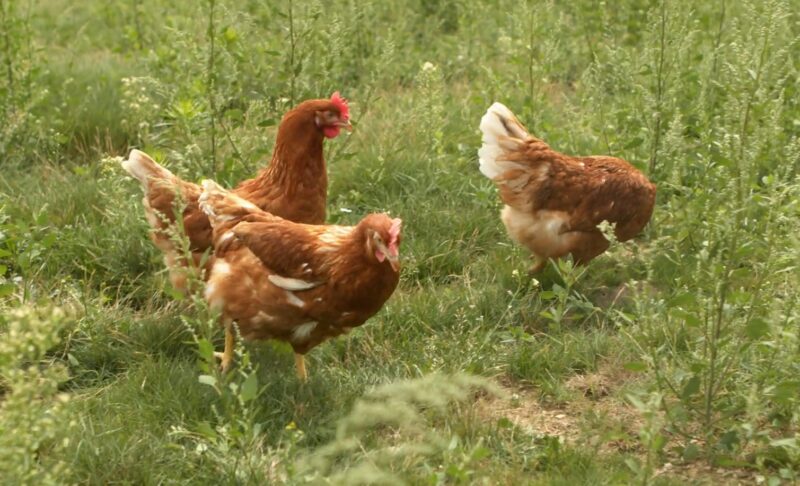
Size and Posture
If you’ve ever seen a rooster and hen side by side, you’ll probably notice the difference in size first. Roosters are usually larger, with a tall and upright posture that makes them look even more imposing.
Their strong, thick legs are built for defense, often equipped with sharp spurs that come in handy during territorial disputes or when protecting the flock from predators. Hens are more compact and rounded, with slimmer legs and a shorter stance.
They don’t develop the same kind of spurs, though some hens may have small, non-functional ones. The difference in body shape reflects their distinct roles in the flock.
Combs and Wattles
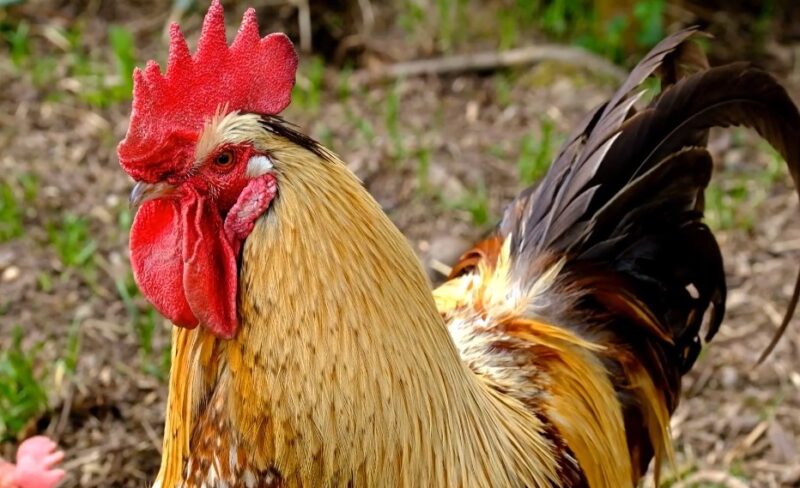
Roosters also sport larger combs and wattles than hens. The bright red comb on a rooster’s head serves more than just decoration—it’s a sign of his health and virility. A bigger, brighter comb tends to indicate a dominant rooster that’s ready to take charge and attract hens.
Chickens are generally hardy animals but can be susceptible to diseases like avian influenza, respiratory infections, and even conjunctivitis, requiring proper care, vaccination, and clean living conditions to maintain good health.
Hens have combs too, but they’re usually smaller and less pronounced. The size of a hen’s comb can vary by breed, but it’s primarily functional for regulating body temperature rather than attracting mates.
Feathers and Tail
Roosters have the dramatic flair when it comes to feathers. Their long, pointed hackle and sickle feathers are often glossy and eye-catching. A rooster’s tail feathers, in particular, are striking and long, making them stand out in a crowd.
This impressive feather display is part of what helps roosters signal their dominance and appeal to hens. In contrast, hens have softer, rounder feathers.
Their plumage serves more practical purposes—providing warmth and helping them blend in with their surroundings to stay safe from predators. Hens don’t have the long, showy tail feathers that roosters flaunt.
3. Functional Differences in the Flock
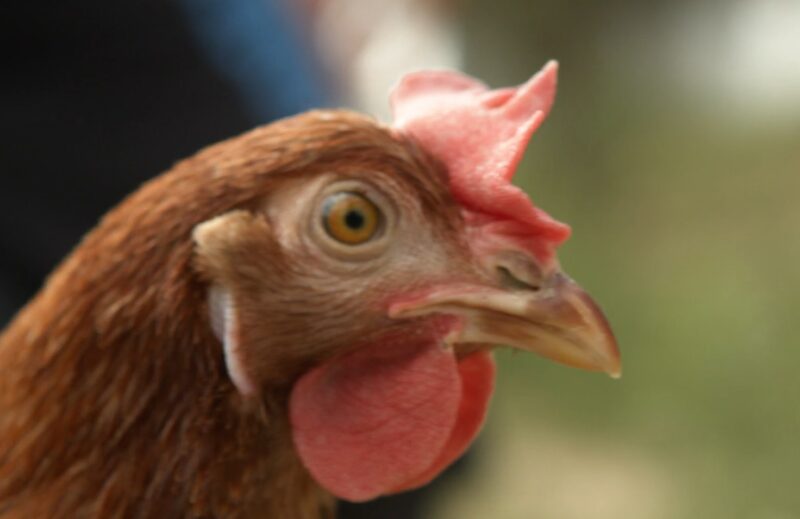
Protection and Leadership
One of the key roles of a rooster in a flock is protection. Roosters are natural leaders, always keeping an eye out for threats. When danger is near, a rooster will let out a loud, unmistakable call, signaling the hens to take cover.
If push comes to shove, roosters will confront and fight off predators to defend their flock. Their combative nature, combined with their physical strength, makes them well-suited for this task. Hens don’t usually take on the protector role.
They’re more focused on foraging and raising chicks. In flocks without a rooster, hens may become more vigilant, but they simply aren’t built to fight off intruders the way roosters are.
Egg Laying and Reproduction
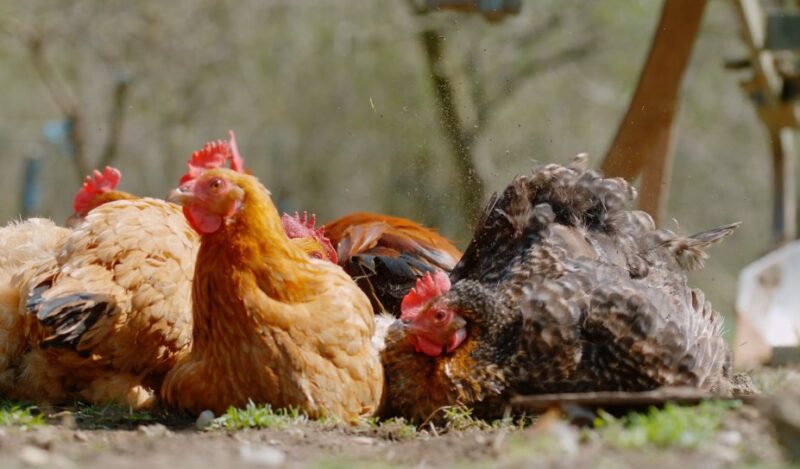
Egg laying is, of course, the domain of the hen. Hens will lay eggs regularly, with or without a rooster’s presence. If a rooster is part of the flock and mates with the hens, their eggs will be fertilized and capable of hatching into chicks.
Without a rooster, hens will still lay eggs, but those eggs won’t hatch into chicks. Roosters don’t lay eggs, but their contribution to reproduction is vital. Mating with a rooster ensures that the eggs will be fertilized, leading to the possibility of growing the flock.
Flock Organization
Roosters are flock organizers. You’ll often see them guiding the hens to forage in different areas and keeping them together. They help maintain peace among the hens, especially when disputes arise.
A rooster’s leadership role is essential to the smooth functioning of the flock. In the absence of a rooster, a dominant hen might step in to organize the group, though her leadership style tends to be less assertive.
Hens are more focused on their immediate tasks—eating, foraging, and caring for their young. Without a rooster around, the flock’s dynamics shift, but hens don’t naturally gravitate toward a leadership role in the same way.
The Bottom Line
Roosters and hens may both be chickens, but their differences are vast, and each plays a vital role in the overall harmony of the flock. Roosters are protectors and leaders, known for their assertiveness and flamboyant physical traits.
They’ll defend their territory, keep the flock organized, and mate with the hens to ensure fertilized eggs for future generations. Hens, meanwhile, focus on nurturing. Their egg-laying abilities and broody nature are crucial for reproduction, and while they tend to take a backseat in terms of leadership, they’re no less important.
Hens are the backbone of the flock, providing sustenance and caring for chicks when the time comes. It’s amazing to see how nature divides responsibilities between the sexes, even within a species as familiar as chickens.
Whether it’s the protective crow of a rooster or the soft cluck of a hen calling her chicks, both have distinct roles that keep the flock thriving. By knowing these differences, anyone raising chickens can better appreciate the unique contributions of roosters and hens.
Each one, in its own way, plays an indispensable part in the flock’s social structure, protection, and reproduction, creating a balanced and cohesive unit.
Related Posts:
- What Is a Bushel? Common Agricultural Terms Explained Simply
- Can Gallstones Cause Fatigue And Dizziness?…
- What Causes White Spots on Cucumber Leaves and How…
- 10 Key Nutrient Deficiencies in Plants and How to…
- Alpha Palm Vitamin - Nutritional Value And Benefits
- Short and Fat Zucchini? Here’s What Could Be Going Wrong




